We all know snakes aren't evil, but a lot of people find them incredibly creepy. Thanks to their tongues, teeth, and legless bodies, serpents are often portrayed as villains in bad Syfy movies and novels featuring noseless wizards. True, snakes keep the rodent population under control, but due to eerie facts like these, plenty of people still think they're awfully freaky.
我们都知道蛇不是恶魔,但是很多人却十分害怕。因为它们的舌头、尖牙和没有四肢的躯干,蛇在美国Syfy频道的垃圾电影和故事里的巫师没有鼻子这类小说里,常常被刻画为坏蛋。当然,蛇控制着啮齿类动物的数量,但是由于前面那些莫名其妙的事实,蛇仍然让无数人感到十分恐惧。
10.蛇屋
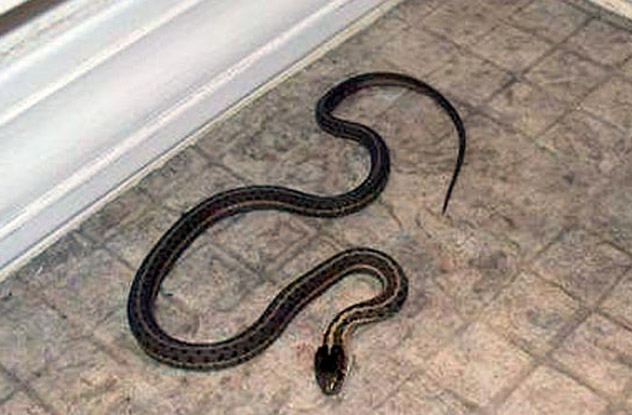
Ben and Amber Sessions thought they were getting a great deal. Their five-bedroom house in the country cost only $180,000. If only they'd watched more horror movies, they would've known something was up, especially once the realtor started talking about the "previous family."
本(Ben)和安伯·塞森斯(Amber Sessions)以为他们赚了一个大便宜。他们在乡村带5间卧室的房子只花了18万美元。如果他们看过的恐怖电影再多些就好了,他们就会知道一定发生了什么事,尤其是当房产经纪人开始说到"前面的住户"时。
Evidently, that family hadn't wanted to pay their mortgage, so they'd made up a tall tale about a snake infestation. Of course, it was totally untrue, the real estate agent assured Ben and Amber. Happy to get such a great house, the Sessions signed a paper acknowledging the crazy serpent story and found themselves the owners of a new house. Then their lives turned into a nightmare.It started when Amber found eight garter snakes slithering around the house. Soon, the snakes were popping up everywhere. They were swimming in their well, releasing a musk that tainted the water. Sometimes, so many congregated in the yard that the ground looked alive. Even worse, when the Sessions went to sleep, they were serenaded with the sound of hundreds of garter snakes crawling through the walls.Unknowingly, the Sessions had moved into a house built on top of a hibernaculum, which is a hangout where snakes sleep during the winter. Once things warmed up, the creatures awoke and invaded the Sessions' new home. The family was in no real danger. Garter snakes are only mildly venomous and can't harm humans. Still, there's something inherently revolting about sharing a house with innumerable reptiles. As Amber put it, "It felt like we were living in Satan's lair." The couple declared bankruptcy and moved out as fast as they could.
很明显,那一家人不愿偿付按揭贷款,所以他们编造了一个半真半假的故事,说有蛇侵入。当然,这完全不是真的,房产经纪人向本和安伯保证。塞森斯一家很高兴能得到这么大一所房子,签署了一份确认蛇的恐怖故事的文件,立即成为了新房子的主人。随后,他们的生活变成了一场噩梦。噩梦始于安伯发现8条袜带蛇在房子周边游走。很快,到处都出现了这些蛇。他们在井里游动,放出的麝香味污染了水。有时候,院子里聚集了太多蛇,地面看上去都像是活动的。还有更严重的,当塞森斯一家睡觉时,他们耳边会奏起几百条袜带蛇从墙上爬过发出的乐声。这所房子建在动物冬伏地上面,塞森斯一家不明就里地搬了进去——蛇经常在这里出没,冬天则在这里睡觉。一旦气候变暖,这些动物醒来,便侵入塞森斯的新家。这家人其实没有面临多大危险。袜带蛇是性情温和的毒蛇,不会对人类构成危害。但是,与数不胜数的爬行动物共享一所房子,仍然让人不由自主地反感。就像安伯说的,"好像我们住在撒旦的巢穴中。"这对夫妻也宣称破产,尽快搬走了。
9.The Snake That Steals Poison From Toads
9.偷蟾蜍毒液的蛇
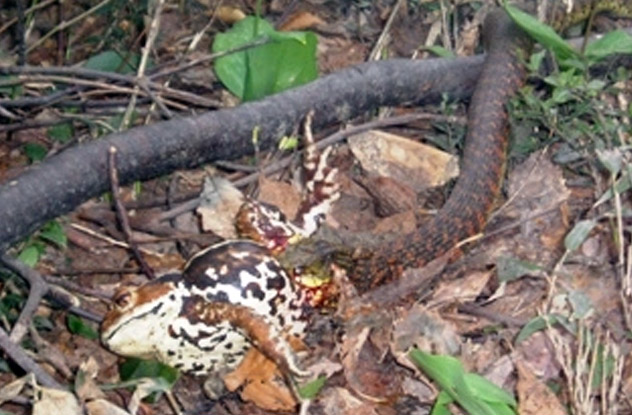
There's a difference between poison and venom. Sure, they'll both kill you, but venom is injected through a bite or sting, while poison has to be swallowed or inhaled.
毒素和动物毒液有所区别。当然,它们都会使人致命,但是动物毒液是通过叮咬注入人体的,而毒素是被人咽下或吸入的。
Now let's focus on the tiger keelback. Unlike cobras or mambas, this Japanese serpent is non-venomous. If it bites you, it'll hurt, but you could shake it off and just walk away. But while the tiger keelback lacks fangs, it does pack two glands brimming with poison on the back of its neck. These nuchal glands release toxins called "bufadienolides," which attack the heart and make breathing difficult. However, the keelback can't actually produce poison. So where are these chemicals coming from? Tiger keelbacks love chowing down on toads, and these warty amphibians have glands overflowing with bufadienolides. When snakes pig out on a bowlful of toxic toads, they load up on poison to fight off predators. Their bodies then modify the poisons to make them even more powerful. These supercharged substances give the snakes a confidence boost, so chances are slim that they'll back down from a fight. If you ever see one of these guys slithering across your path, don't pick it up.
现在我们集中讨论一下赤练蛇(tiger keelback)。与眼镜蛇和曼巴蛇不同,这种日本蛇没有毒性。如果被它咬到,你会感到疼痛,甩掉它,走开就可以了。但是,尽管赤练蛇没有毒牙,它颈部背后有两个装满毒液的腺体。这些颈部腺体释放的毒素叫做"蟾蜍二烯羟酸内酯",可以影响心脏,让呼吸困难。但是,赤练蛇其实不能产生毒液。那么这些化学物质又来自哪里呢?赤练蛇喜欢吃蟾蜍,而这些长疣的两栖动物长有一些腺体,里面充满蟾蜍二烯羟酸内酯毒素。当蛇吃下大量有毒的蟾蜍后,它们贮存毒素,以备回击对手。它们的身体会对毒液进行改造,甚至增加其毒性。这些增强自身力量的物质让这些蛇信心大涨,所以它们面对挑战几乎从不退缩。如果你看见路上溜过一条,别去捉它。
8.单性生殖
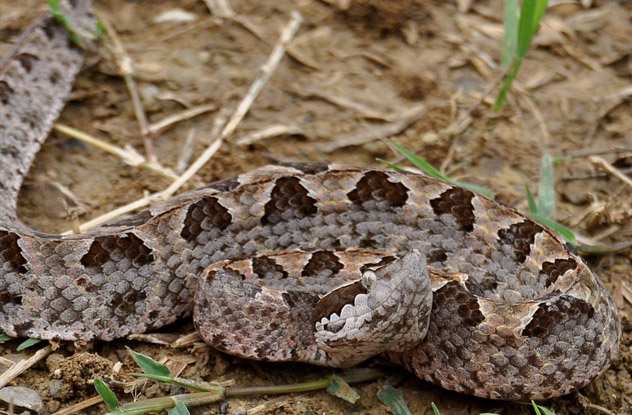
Scientists have known for some time that female vertebrates don't always need males to conceive. This process is called facultative parthenogenesis, and chickens, turkeys, sharks, and Komodo dragons are all able to reproduce without male assistance. But all those animals have been observed in captivity. No one had ever found a vertebrate virgin birth in the wild until 2012, when scientists studying the spawn of North American cottonmouths and copperheads found that 2.5–5 percent of all pit viper litters were born without fathers.
科学家早已知道,雌性脊椎动物受孕不一定需要雄性。这个过程叫做兼单性生殖,家养鸡、火鸡、鲨鱼和最大的蜥蜴科莫多龙都能在没有雄性的情况下繁殖后代。但是,所有这些动物都是在隔离环境下进行观察的。直到2012年才有人在野生自然状态下发现单性生殖的例证——当研究北美食鱼蝮和铜头腹蛇的卵时,科学家发现2.5%~5%的响尾蛇科毒蛇的幼蛇都没有爸爸。
While scientists aren't exactly sure what causes facultative parthenogenesis to occur in wild vipers, they know the process starts with meiosis. That's the phase of sexual reproduction when sex cells divide in two halves, each with half of the chromosomes needed to create a new snake. Usually, these haploid cells need input from the father, but in bizarre cases, the mother's cells merge with each other and create future serpents. For the most part, scientists think these virgin birth babies are sterile, but in 2012, one researcher claimed he found a garter snake that gave birth to fertile offspring.
科学家还不十分明确导致野生毒蛇出现偶发单性生殖的原因,但他们知道这个过程始于减数分裂。减数分裂是有性生殖的一个阶段:生殖细胞分成两部分,每部分带有一半创造新生命所需要的染色体。通常,这些单倍体细胞需要父方染色体;但是在特殊情况下,母方卵细胞相互融合,产生未来的小蛇。科学家认为绝大部分通过单性生殖出生的幼蛇都没有生殖能力,但2012年,一位研究人员声称发现一条袜带蛇产出了具有生殖能力的后代。
7.Boas Sense Your Heartbeat
7.蟒蛇感觉你的心跳
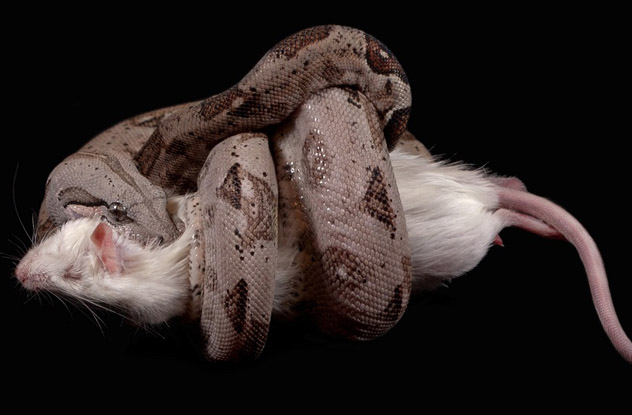
Occasionally reaching 5.5 meters (18 ft), boa constrictors are some of the most affectionate animals on the planet. All they want to do is hug you—to death. While they don't eat people, they have been known to cuddle with humans from time to time.
体长达5.5米(18英寸),蟒蛇是地球上满怀爱意的动物之一。它们只想拥抱你——让你窒息。它们虽然不吃人,但是时不时拥抱人。
Once a boa wraps you up, there's no way you can play possum and hope the snake lets you go. While you might close your eyes and hold your breath, the constrictor isn't fooled. It can feel your heart beat.Researchers from Dickinson College stuck simulated hearts into dead rats and gave the rodents to hungry snakes. The fake hearts were connected to a pump that scientists controlled from a distance, and they varied the amount of time the hearts beat from feeding to feeding. Boas let go sooner if the heart wasn't beating at all. And if the heart pumped for longer than 20 minutes, they actually gave up. Since they could feel the organ beating away seemingly endlessly, they figured it wasn't worth spending so much energy on such a scrappy rat.
一旦被蟒蛇缠住,你装死是没用的,更别希望蟒蛇会把你放掉。尽管你闭上眼睛、屏住呼吸,蟒蛇也不会上当。它能感觉到你的心跳。迪金森学院的研究人员将模拟心脏植入老鼠尸体,把老鼠放在饥饿的蛇面前。人造心脏与远处科学家控制的泵相连,他们变换心脏跳动的时间,重复投放老鼠进行试验。如果心脏根本不跳动,蟒蛇不久就会松开老鼠。如果心脏跳动时间持续20分钟以上,它们就会放弃。它们既然感觉心脏无休止地跳动下去,就会发觉不值得为一只精力如此旺盛的老鼠花这么大力气。
6.The Disease That Makes Snakes Tie Themselves In Knots
6.让蛇把自己打成结的疾病
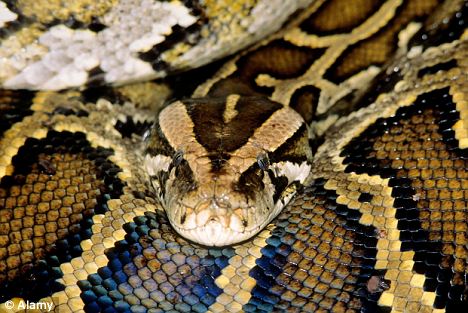
Without a doubt, the two scariest words in the English language are "new virus." Whenever scientists discover one of these infectious agents, there's always a chance it might start a global pandemic of Stephen King proportions.
毫无疑问,英语里最让人惊慌的词语就是"新病毒"。无论科学家什么时候发现了一种传染性病原体,它未来总可能会像史蒂芬·金的畅销作品那样迅速传播,引发全球流行病。
And humans aren't the only creatures that worry about the viral apocalypse. In 2009, snakes at the Steinhart Aquarium in California were hit with a mysterious virus that scientists had never seen before. While the new pathogen didn't turn the serpents into killer rage monsters or cause their flesh to fall off their bones, the symptoms were nearly as disturbing.Boas and pythons infected with this deadly virus suffer from a debilitating illness called "inclusion body disease." In the first stage of this sickness, the snake vomits uncontrollably. Next, it starts acting like it's had too many drinks, swaying back and forth, flipping over on its back, and staring at the sky like it's watching the stars. And then things get really gross. The snake crawls over its own body, back and forth, until it's tied itself into one big knot that it can't undo.The disease is caused by an arenavirus, an agent distantly related to the pathogen that causes Ebola. The arenavirus attacks the brain, making the snake work itself into the world's most horrifying bow. There's no cure for inclusion body disease, and any snake that gets infected has to be put down. The only silver lining here is humans can't contract the same affliction, which is great news, as the results wouldn't be pretty.
人类不是唯一担心病毒灾难的生物。2009年,加利福尼亚州斯坦哈特水族馆(Steinhart Aquarium)的蛇受到一种神秘病毒侵害,科学家从没见过这种病毒。虽然这种新型病原体没有把这些蛇变成暴躁的杀手怪物,也没有让它们的肌肉从骨骼上脱落,它们出现的症状还是让人们感到不安。受到这种致命病毒感染的蟒蛇和巨蟒忍受着一种疾病的折磨,逐渐衰弱,这种病叫做"包涵体疾病(inclusion body disease)"。患病初期,蛇会身不由己地呕吐。然后,它们的举动像喝多了酒一样,来回摇晃,背腹翻转,盯着天空,好像在看星星似的。以后情况就严重多了。它们在自己身上爬行,反反复复,直到把自己打成一个自己也解不开的大大的结。这种疾病是由沙粒病毒(arenavirus)引起的。这种病原体与引起埃博拉传染病的病原体有一点关系。沙粒病毒攻击大脑,让蛇把自己打成世界上最恐怖的结。现在还没有治疗包涵体疾病的药物,所有被感染的蛇只有死路一条。唯一的安慰在于,人类不会受到相同的感染,这个消息极好,因为感染没有好结果。
















